Vegetarian Thai Green Curry combines a medley of aromatic veggies with a vibrant green curry paste, tender butternut squash, and crisp snow peas in a creamy, indulgent coconut base. Top your bowl with fresh lime and basil for a meal you won’t be able to get enough of!
This curry is naturally vegetarian, but still has a good amount of plant-based protein, thanks to the chickpeas. That said, it’s easy to add in additional protein — add in some prepared tofu, cooked shrimp, or cooked chicken.
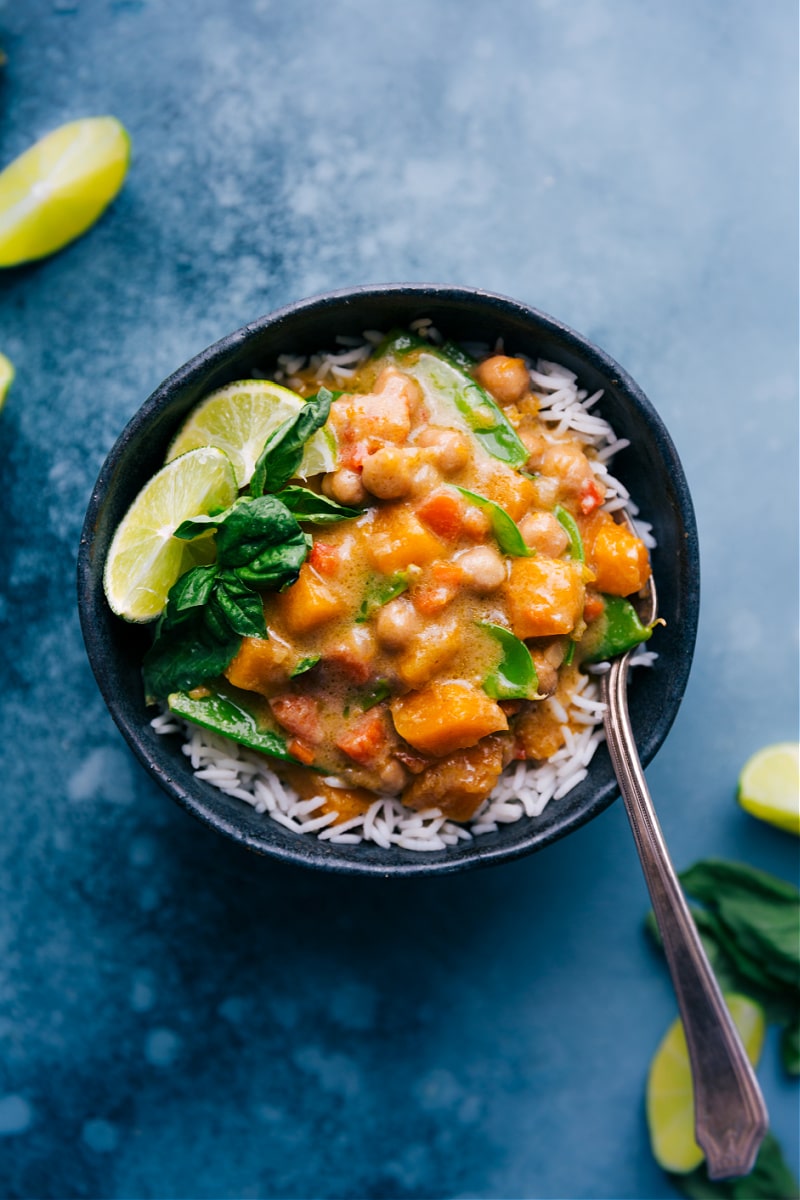
Vegetarian Thai Green Curry
For some serious comfort food, you’ve come to the right recipe — this Thai Green Curry feels like a hug in a bowl! It’s rich, creamy, and indulgent tasting while being loaded with good-for-you ingredients and a ridiculous amount of veggies. And the best news is these are veggies your kids won’t turn their noses up at — who can resist ’em when they’re bathed in such a luxurious curry sauce?!
Let’s Chat Green Curry Paste
The green curry paste in this recipe is the main flavor of this dish. Over the past few years, red and green curry paste have become more mainstream and easier to find in regular grocery stores.
- Where to find: You’ll likely find it in the international section or aisle of your grocery store. If you’re near an Asian grocery store, you’ll certainly find it there. It’s also very easy, cheap, and convenient to purchase online.
- What it tastes like: Green curry paste will differ a bit from brand to brand but typically you’ll find the following ingredients in the paste: fresh green chiles, garlic, wild ginger, shallot, lemongrass, salt, Kaffir lime, sugar, galangal, spices (coriander seeds, cumin, cardamom, turmeric), pepper. Green curry paste can be fairly spicy depending on the brand.
- What brand to use: If you have special dietary restrictions you’ll want to check the ingredients of the curry paste — a lot contain fish sauce or shrimp. If you’re vegetarian or vegan, you’ll want to make sure the brand you use meets that requirement. If you’re gluten-intolerant, check for that too — a lot of curry pastes are made without gluten. My favorite brand to use is Maesri® and Thai Kitchen® is another one we’ve used in this Vegetarian Thai Green Curry.
- How much curry paste to use: The intensity of the curry paste will vary from brand to brand. We typically use about 4 tablespoons of Maesri curry paste and 6 tablespoons when using Thai Kitchen — both of these amounts ensure bold flavors without too much heat, since the coconut milk sweetness offsets the heat so much.
Vegetarian Thai Green Curry Ingredients
There are a few ingredients worth mentioning and offering suggestions or substitutes for:
- Kaffir lime leaves are a key ingredient in Green Curry. They add a vibrant, citrus flavor, but can be tricky to find — I’ve only had success finding them at my local Asian market. If you have access to some, crumple a few up and throw them in when you add in the coconut milk and remove them before serving. To get a citrusy flavor without the leaves, zest and juice a lime and mix through right before serving. When I do find Kaffir lime leaves, I seriously stock up — they actually freeze wonderfully! I’ll keep the bag in the freezer and use them as needed.
- Fish sauce is a common finishing ingredient in Thai curries — it adds that final seasoning and umami flavor. If you aren’t vegetarian, feel free to add some in, but since I wanted this to be a vegetarian recipe, I use soy sauce instead. Use regular (not lite) soy sauce. Tamari can be used instead of soy sauce if preferred.
- Thai Basil is the preferred topping for Vegetarian Thai Green Curry, but I can’t ever get my hands on it where I live. If you can, great — use that! If not, we enjoy regular basil on this curry!
- Lemongrass paste is another tricky-to-find ingredient that adds loads of flavor. I’ve had no problem finding it at my local Asian market, but typically purchase it online for ease.
- Coconut milk. More on this ingredient below
Coconut Milk
Coconut milk is an integral part of this recipe. It’s sweet and nicely balances the spice from the curry paste. It’s also thick and creamy which makes this curry very rich and indulgent tasting.
To mimic the thickness, sweetness, and richness of green curries I’ve had from Thai restaurants, I created this recipe with 2 cans of coconut milk. If 2 cans are too much for you, use 1 can of coconut milk and replace the other can with 1 cup of vegetable (or chicken if you aren’t vegetarian) stock. You may need to add a bit more sugar to compensate for this change so the curry isn’t overly spicy.
It can be overwhelming to navigate coconut milk in the grocery store. Look for shelf-stable, not refrigerated, cans of coconut milk. You’ll find canned coconut milk on the international aisle, with Latin or Asian products. Here’s an article outlining the best brands to use. I personally use Imperial Kitchen® since I can find it often at my local grocery store and enjoy the richness of this brand. Use full-fat coconut milk for the best flavor and thickness. Lite coconut milk won’t thicken and give you the rich, full flavor that regular coconut milk will. Cream of coconut is far too sweet and coconut cream tends to be too thick (and overpoweringly coconut flavored) for this curry.
Vegetarian Thai Green Curry Tips
- Take time to sauté the curry paste and seasonings. Instead of immediately dumping everything else into the pot, we want to take time to sauté everything thoroughly, which creates a more heightened flavor dimension.
- In order for everything to cook in time and ensure the veggies are tender, it’s important to cut the butternut squash into small, even pieces (1/2-inch pieces). Check out this roasted butternut squash post for step-by-step photos on how to prepare and chop a squash or see the “short-cut” idea below!
- Finishing the curry. After the curry has thickened and squash is tender, it’s time to really bring the flavors alive! This is where some taste testing and experimentation come on your part. Add fresh lime juice and zest, sugar, soy sauce, salt, etc. all to personal preference. The amounts of these ingredients will vary based on the curry paste and coconut milk you used and your personal taste preferences. Salt is hugely important in helping to bring out and enhance existing flavors.
Shortcuts
For a quicker prep time, use a bag of already cut butternut squash in the produce section of the store. If the pieces are too large, cut them down a bit so they’ll cook in time for this Vegetarian Thai Green Curry.
Storage
Vegetarian Thai Green Curry Storage
One of my favorite things about curry recipes is how well they store! Leftovers only get more and more flavorful as they sit. Store any leftover curry in an airtight container in the fridge for 3-5 days. Reheat over low heat, adding a splash of vegetable broth/stock (chicken stock if you aren’t vegetarian) as needed to thin the sauce.
Freeze leftovers in an airtight container for up to 3 months. Defrost fully in the fridge before reheating on the stovetop.
More vegetarian recipes to love
- Vegetarian Chili Mac made in one pot!
- Chickpea Curry with red curry paste
- Vegetarian Gyros with quick Tzatziki sauce
- Vegetarian Enchiladas with black beans and corn
- Sweet Potato Coconut Curry Soup with chickpeas
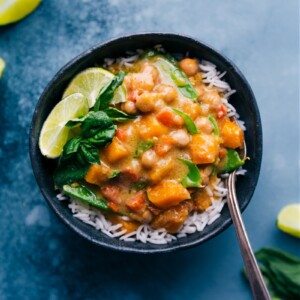
Vegetarian Thai Green Curry
Equipment
Ingredients
- 2 tablespoons coconut oil
- 1 cup finely diced red onion 1 large red onion
- 1 cup finely diced red bell pepper 1 bell pepper
- 1 cup finely diced carrots 3 to 4 large carrots
- 1 tablespoon minced garlic cloves 4 cloves
- 2 teaspoons minced ginger
- 1 tablespoon lemongrass paste see note 1
- 1 teaspoon salt
- 4 tablespoons green curry paste up to 6 tablespoons, see note 2
- 1-1/2 teaspoons ground coriander
- 3 cups butternut squash
- 1 (15.5-ounce) can chickpeas
- 2 (13.5-ounce) cans coconut milk see note 3
- 8 Kaffir lime leaves optional, see note 4
- 1-1/2 cups snow peas trimmed and halved
- 1-3 tablespoons light brown sugar see note 5
- 1 tablespoon soy sauce see note 6
- 1 to 2 tablespoons lime juice to taste
- Thai basil or regular basil, for garnish
- Cooked rice optional, for serving
- Warmed roti bread optional, for serving
Instructions
- Dice red onion, carrot, and bell pepper (by hand or quickly in the food processor). Mince garlic and ginger. (I peel the ginger with a spoon or vegetable peeler first.) Peel and chop butternut squash into bite-sized pieces (1/2-inch in size) so they’ll cook at the right time. Drain and rinse chickpeas.
- Heat coconut oil in a large pot over medium-high heat. Add onion, carrot, and red pepper and sauté 7–9 minutes, or until onions begin to turn golden. Add garlic, ginger, and lemongrass paste. Stir to coat everything with oil. Season to taste with salt (I add 1 teaspoon salt.) Lower heat to medium and add green curry paste and ground coriander. Stir often, 2–3 minutes or until very fragrant. Add chickpeas and butternut squash and stir to coat, 1 minute.
- Pour in coconut milk. Stir. Scrape the bottom of the pot and press all squash below the liquid. Bring to a boil, then reduce heat to a rapid simmer (it should be bubbling at the edges but not boiling),18–25 minutes, stirring occasionally. The butternut squash should be fork tender and curry sauce reduced; this happens at around 20–22 minutes for me. If the sauce is reducing too quickly and squash isn’t getting tender, add a splash of vegetable stock/broth or water. (You also may need to lower the heat a little.) If squash isn’t getting tender and the sauce isn’t reducing, increase heat slightly. Add snow peas and cook 2–3 more minutes or until tender.
- Add sugar (start with less; you can always add more), soy sauce, and lime juice to the curry (feel free to adjust these ingredients to personal preference -- adding more soy sauce for seasoning/umami flavor, more lime for a fresh flavor, and more sugar if it’s too spicy). Taste and add more salt if needed; I typically add another 1/4 up to 1/2 teaspoon—flavors should be vibrant!
- Remove curry from heat. Garnish individual bowls with basil. I like to serve lime wedges on the side! Serve over cooked rice with warmed roti bread. Enjoy!
Video
Recipe Notes
Nutrition
Nutrition information is automatically calculated, so should only be used as an approximation.
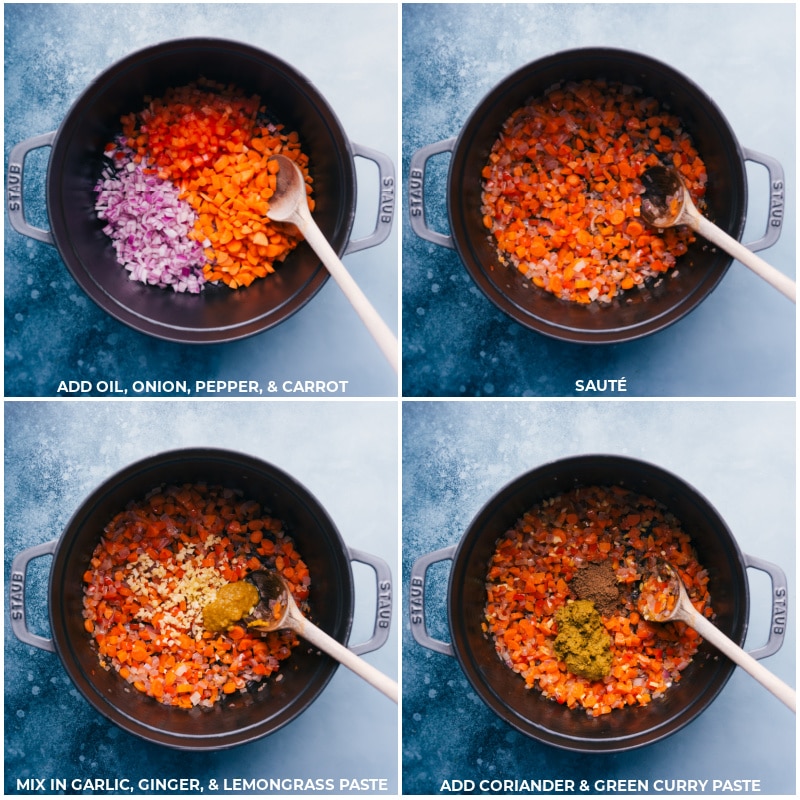
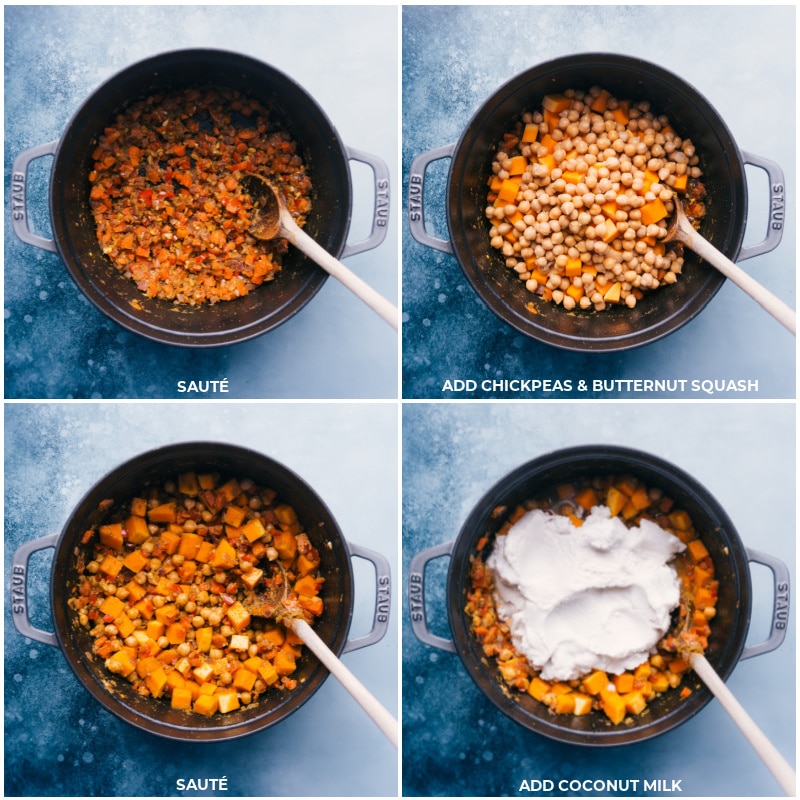
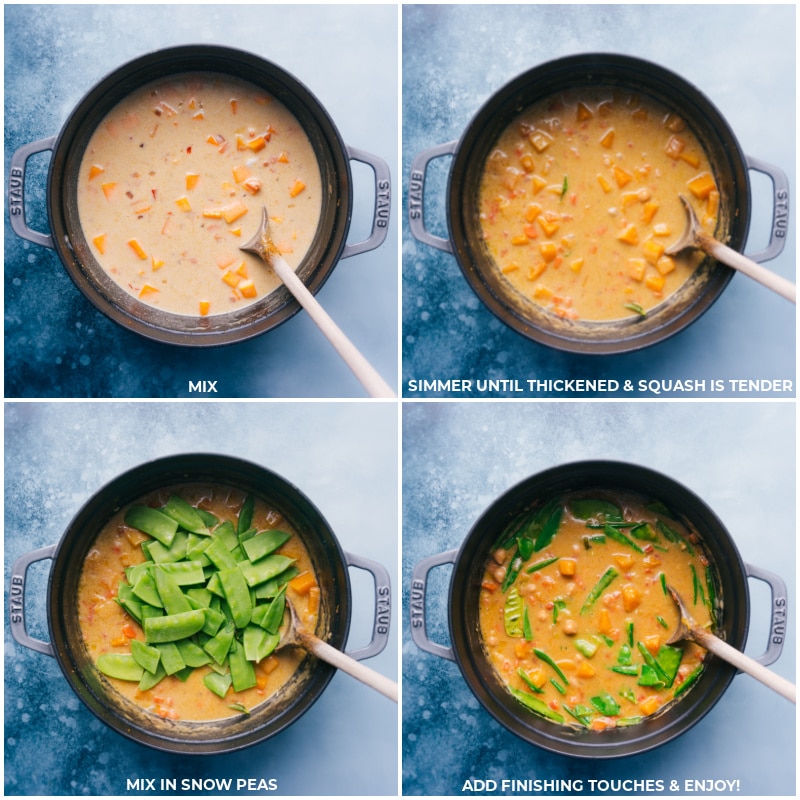
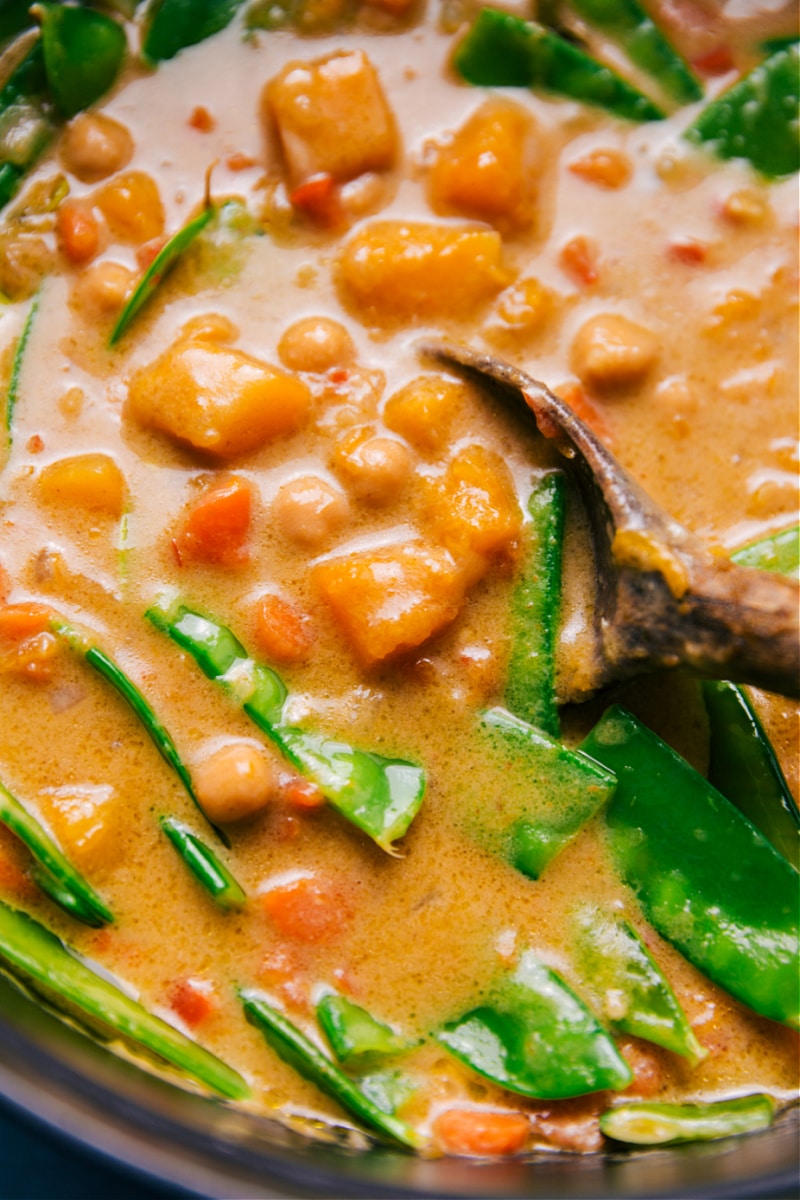


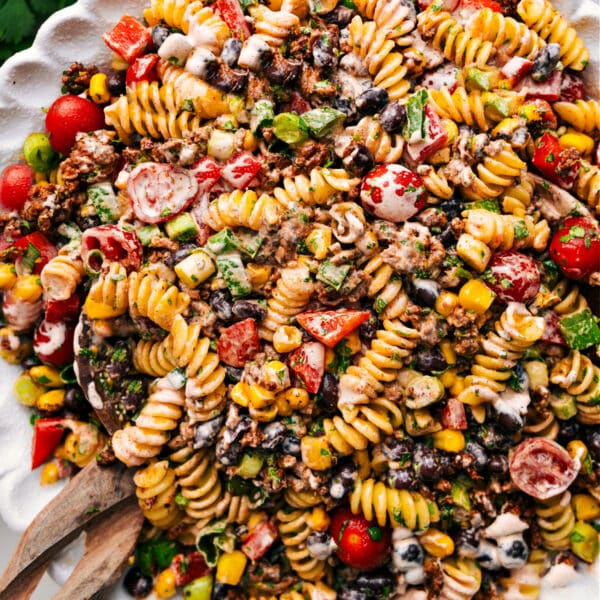

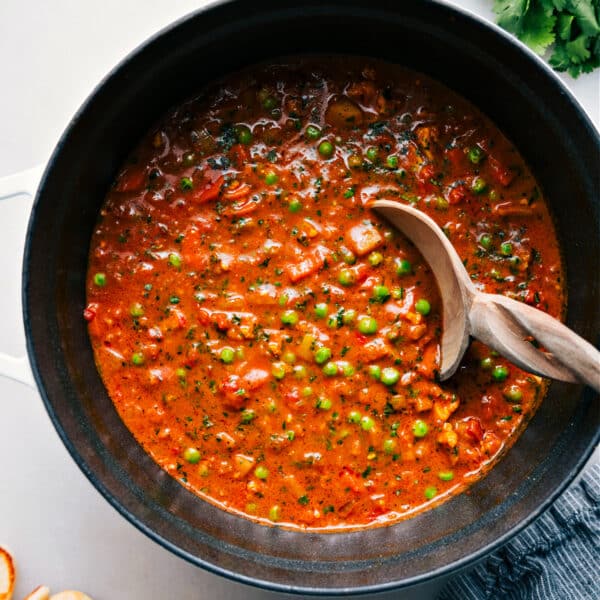
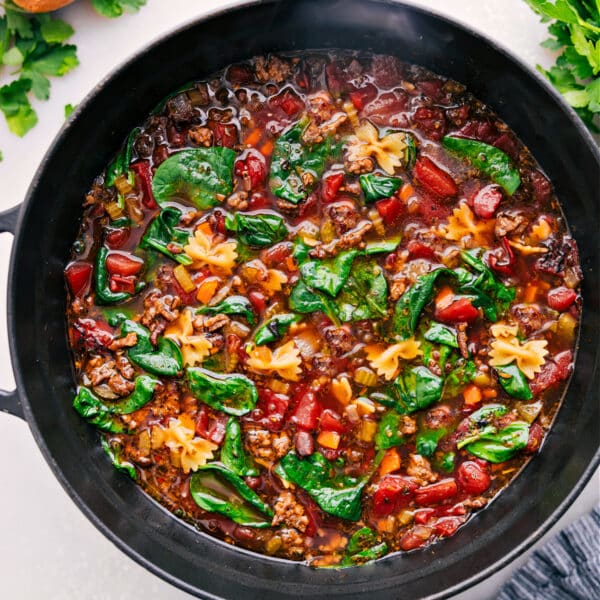









I loved this recipe’s smooth flavor! Great way to incorporate veggies too! I did sub the soy sauce with fish sauce for a non vegetarian option as she suggests. So yummy!
So glad to hear you enjoyed this recipe! Thank you so much for taking the time to leave a comment and review 🙂